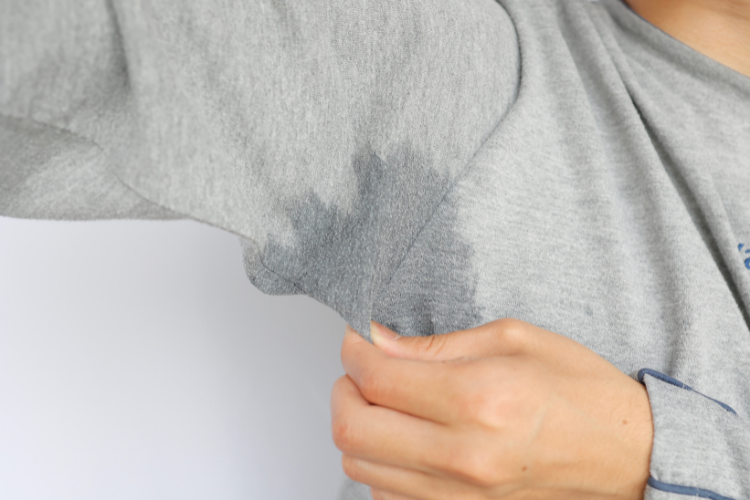The Hédonist Labs team
It can be smelly, but do we know what's in it? Our sweat says a lot about us!
How fascinating is our sweat? In any case, its composition can tell us a lot.
This transparent liquid is secreted by the skin's sweat glands. Its main role is to regulate body temperature by evaporating on the surface of the skin, thus cooling the body in hot weather or when physical activity increases.
As well as regulating temperature, sweat also eliminates toxins from the body and helps maintain skin hydration.
Sweat is mainly composed of water (around 99%), mineral salts such as sodium, potassium, calcium and magnesium, and small quantities of other compounds such as urea, ammonia and amino acids.
The chemical composition of sweat can vary depending on a number of factors. For example, in hot weather, the body produces more sweat to help regulate body temperature, resulting in a higher concentration of mineral salts in the sweat. Similarly, during intense physical activity, sweat will contain more mineral salts and other compounds due to the increased production of body heat.
Health conditions can also influence the composition of sweat. For example, certain illnesses can lead to variations in the levels of certain compounds in sweat, which can sometimes be detected by specific medical tests.
WATER IN SWEAT
Water plays a crucial role in regulating body temperature through sweat. When the body begins to overheat, usually due to the surrounding heat or physical exertion, the skin's sweat glands release sweat onto the skin's surface. This sweat then evaporates, absorbing body heat in the form of thermal energy, which cools the skin and, consequently, the body.
During physical activity, the body generally produces more heat due to increased muscle metabolism. To compensate for this increased heat and maintain a stable body temperature, the sweat glands secrete more sweat.
The amount of water lost through sweat during physical activity can vary depending on factors such as exercise intensity, ambient temperature, the body's previous hydration level and the individual's physical condition.
In general, during physical activity, a person can lose between 0.5 and 2 liters of water per hour through perspiration, or even more in extreme conditions. That's why it's essential to stay hydrated by drinking enough water before, during and after exercise to compensate for water loss through sweat and avoid dehydration.
MINERAL SALTS (ELECTROLYTES) IN SWEAT
Mineral salts present in sweat include sodium, potassium, chloride, calcium and magnesium.
These electrolytes play an essential role in maintaining the body's electrolyte balance and hydration. They help regulate the passage of fluids and nutrients across cell membranes, contribute to muscle contraction, nerve transmission and maintain acid-base balance.
In addition, they are involved in the regulation of osmotic pressure and blood volume, which is crucial to the proper functioning of the body's organs and systems.
Sweat also contains other components such as organic acids, amino acids and urea. These substances play different roles in the human body. Organic acids can help maintain the body's acid-base balance, while amino acids are building blocks of proteins, essential for growth, tissue repair and many biological functions.
Urea, on the other hand, is a nitrogenous waste product of protein metabolism, and its excretion through sweat contributes to the elimination of waste products from the body. Thus, the presence of these components in sweat helps to maintain homeostasis and eliminate metabolic waste from the body.
Good to know: the composition of sweat can be influenced by several factors:
- Physical activity and exercise intensity Physical activity: As physical activity increases, the body produces more heat, resulting in increased sweat production to help regulate body temperature. Exercise intensity can also influence the amount of mineral salts and other compounds excreted in sweat.
- Ambient temperature and humidity level Ambient temperature and humidity: In conditions of high heat and humidity, the body perspires more to cool itself, which can lead to greater loss of fluids and mineral salts through sweat.
- Medical conditions Certain medical conditions can affect the composition of sweat. For example, metabolic or hormonal disorders can alter the levels of certain components in sweat. In addition, skin diseases such as eczema can alter sweat production.
- Diet Eating habits can influence the chemical composition of sweat. For example, a diet rich in salt can increase the concentration of sodium in sweat.
- Genetic factors Genetic variations can also play a role in the composition of sweat. Some people may have more or less active sweat glands, which can influence the quantity and composition of sweat produced.
How can we analyze the composition of our sweat?
Techniques for analyzing sweat composition generally involve collecting sweat samples using special devices such as patches or sensors, as well as laboratory methods for analyzing sweat components. Sweat samples can be collected on the skin using specific patches that absorb sweat during physical activity, or by using sweat-stimulating devices.
Methods for analyzing sweat samples include chemical techniques such as chromatography and mass spectrometry to identify and quantify the various components of sweat, as well as biochemical techniques to measure levels of certain biological markers.
In terms of emerging technologies, there is growing interest in the development of wearable sensors and micro-fluidic devices that can monitor sweat composition in real time. These technologies enable continuous, non-invasive monitoring of health and physical performance, and could have important applications in health, sport and personalized medicine.
The composition of sweat can have several medical and technological applications:
- Medical diagnosisSweat composition can be used to detect electrolyte imbalances, metabolic disorders, skin diseases and other medical conditions. For example, abnormal electrolyte levels in sweat may indicate disorders such as cystic fibrosis or hyponatremia.
- Monitoring health and sports performanceSweat monitoring devices are developed to enable continuous, non-invasive monitoring of health and sports performance. These devices can measure real-time levels of sweat components such as electrolytes, organic acids and biomarkers to assess hydration, electrolyte balance, physical performance and stress levels.
In short, sweat, although often perceived as a simple physiological reaction, reveals a fascinating complexity. Its varied composition, influenced by a multitude of factors, reveals valuable information about the health and functioning of the human body.
As technology advances, the possibilities for understanding and using sweat to improve health and performance become ever more promising. Whether to diagnose disease, optimize sports training regimes or monitor health in real time, sweat offers remarkable potential.
As we continue to explore the intricacies of this bodily fluid, it's clear that sweat is more than just a drop of perspiration, but rather paves the way for vast possibilities in medicine, sport and human well-being. Its study continues to promise exciting discoveries and breakthroughs that could transform our understanding of health and the human body.




